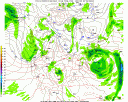From Jonathan Taylor (AIRES Scientist PI):
With the ongoing problems with IASI I wanted to cheer everyone up with news of the excellent data we have gathered so far.
The FAAM BAe146 and the WB-57 have conducted two excellent flights coordinated with the Metop satellite.
The first flight took place coincident with the 0335Z 19th April 2007 overpass of Metop overhead the DoE ARM site in Oklahoma. It was a night time flight and the sub-satellite track of IASI was within 2nm of the ARM central facility. The weather conditions were excellent with totally cloud free conditions prevailing during the flight. The WB57 flew the NAST-I, NAST-M and S-HIS instruments operating at 57,000ft flying a pattern up and down the sub-satellite track. At the same time the BAE146 flew runs at 4000ft (the lowest permitted altitude in that area at night time) and profiled up to 30,000ft before flying at 30,000ft along the sub-satellite track exactly at the overpass. During the overpass time all instruments worked well and the BAe146 launched 11 dropsondes to characterise the temperature and water vapour column. In addition the BAe146 measured the ozone and carbon monoxide profiles in the area. The extremely good coincidence of the WB-57 data and the BAe146 along with the valuable data from the ARM site will make this an invaluable data set for validating the performance of IASI. The atmospheric structure was complex with a moist but cloud free boundary layer – a real challenge for radiometer retrievals.
The second flight took place over the Gulf of Mexico to the South East of New Orleans coincident with the 03:11Z 20th April 2007 overpass of Metop. The FAAM Bae146 took off from Houston and landed briefly at New Orleans to refuel allowing maximum endurance over the area of interest for the overpass time. The WB-57 operated again at 57,000ft with the NAST-I, S-HIS and NAST-M instruments. The BAE146 started the scientific sortie with two runs at 1000ft above the ocean each of 50mins duration. It was a night flight again and the only visible features were the hundreds of oil rigs with their flares and lighting illuminating the ocean surface like a Christmas tree. During these low level runs the ARIES instrument on the BAE146 was used to measure the sea surface temperature which is highly variable in this area showing marked step changes of 1 degree or more over very short distances. The ARIES instrument was also used to measure the down welling radiation at this level which helped with the characterisation of the atmosphere. These measurements of the downwelling radiance spectra, which we could look at in detail during the flight, showed the presence of scattered cumulus, altostratus and cirrus at the Southern end of the run whilst the northern end of the run was totally cloud free. Following the low level runs the BAe146 profiled up through the atmosphere to 33,000ft measuring the state of the atmosphere. The thermodynamic structure was very unusual. The boundary layer was moist up to around 5500ft and then we entered a particularly dry layer with dewpoint depressions approaching 60 degrees Celsius. At 23000ft we entered a moist layer with dew point depressions of only 2 to 5 degrees but there was no cirrus detected by any of the instruments. This very moist layer was 10,000ft thick and it was only at the very top of the layer that we found the cirrus cloud. I have never seen such a deep moist layer at high altitudes without there being cirrus present. During the satellite overpass run the BAE146 and WB-57 flew coordinated runs backwards and forwards along the sub-satellite track. The BAe146 launched 11 dropsondes with 4 dropsondes staggered vertically through the atmosphere at the exact overpass time. All of these dropsondes showed very consistent thermodynamic structure. Whilst at high level the Bae146 sometimes penetrated thin cirrus clouds allowing the microphysics to be characterised. ARIES spectra looking down through the atmosphere showed that the lower level cloud observed earlier had moved away. We will have to look carefully at the Metop data but it is likely that there will mainly be thin cirrus in the IASI fov but we hope that some of the breaks are large enough for clear sky spectra to be measured. All in all this was an excellent flight with some very interesting data from the WB57 and the Bae146 which should keep us busy for some time.
We are all now busy analysing these data and hope to be able to circulate some initial intercomparisons between Metop and the airborne interferometers sometime over the weekend.
Despite the news that Metop has had some difficulties spirits remain high and everyone awaits the return of a fully functional IASI in order that we can go out and gather some more data.
In the meantime we are considering doing a coordinated flight of the WB57 and BAe146 to look at sub-tropical cirrus in coordination with the Aqua satellite, Calipso and Cloudsat (the A-train).

 Joint
Airborne IASI Validation Experiment (JAIVEx) at UW-Madison SSEC/CIMSS
Joint
Airborne IASI Validation Experiment (JAIVEx) at UW-Madison SSEC/CIMSS